| Sea Stories>Research>Shark Bay Project > 2003/1 expedition log |
|
|
Sharks: the first research in the wild in the Mediterranean Sea.
The first campaign scheduled for 2003 to meet the sharks (May 15th-26th) was hugely successful. Read our logbook, now updated with pictures, to learn more on this year's findings which include... lots of pregnant females; a very small juvenile and returning sharks...

You can download a small clip from our new video - just click on this little image, it is about 800K.
Rome, May 15th 2003, h.0800
We are almost ready - camera gear, fins, masks, snorkel (Mares, of course)... 24 hours from now and we will be swimming again with "our" sharks. We will again be snorkelling and not diving - we had hoped to use the Tecnoprene oxygen rebreather but since the official permit to use tanks in the bay - where diving is prohibited - from the Turkish government have not been issued yet, we will have to leave it at home. Too bad!
I hope to be able to regularly update this website, and share with you all what we see in the bay. So as soon as I find an Internet café reports will start coming in. It will again - as usual -fall on Roberto Pachi's shoulders (check his Blackfishtek website, it's really cool!) the task of uploading files (what would I do without you, Roberto!). Must rush now, plane leaves in 3 hours!
Shark Bay, Turkey, May 16th, h15.15 local time
I must admit I was a bit nervous the first 20 minutes or so. No shark in sight. Perhaps the water - 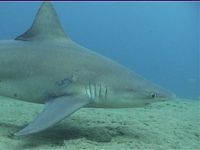 so much warmer than last year - made the sharks arrive sooner in the season, and so by now the would be gone (where??). And then at last we see them - sharks. They are here! so much warmer than last year - made the sharks arrive sooner in the season, and so by now the would be gone (where??). And then at last we see them - sharks. They are here!
We have not had a look yet at last years' pictures, but these sharks seem to be different from the ones we met in 2002 and 2001. They are all females, and quite big too. No male in sight, no juveniles today. One female has a terrible - but healed - wound that runs on her right pectoral fin and on her body as you can see from this picture.
We hope to see - and video or photograph - one of the animals we photo-ID last year. Keep fingers crossed for us! Must rush now, we must go into town and get food and water, mosquito-repellent and... sheets. The place where we stay is quite... basic!! By the way - we were showered by emails from many of you, all wishing us good luck with our sharks. It feels good to have you all behind us. Thanks! And thanks to Roberto Pachi' from Blackfishtek who is uploading these pages on my website. Ciao!
May 16th, evening
We received an alarming email from Hemlut Debelius, a very well-known photographer and author of several marine books and owner of photo agency IKAN. A photographer he knows, who was here last week, says that most of the sharks were taken in nets. We are perplexed. True, the first impression was of fewer sharks than last year but that could be due to several factors. And then: he spoke of nets, and it is true that a big chunk of a net is stuck on the rocks. But it seems to be a bit too "frail" for these sharks. We asked Helmut to dig out some more information, we will let you know.
May 17 th
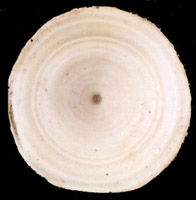 |
| How old is a shark? You can age a shark by counting the growth lines in the vertebrae, just like you do with trees. |
The sharks are very nervous. It's the w-e, there are many people around and two boats keep motoring back and forth along the bay trying to see sharks. As they can't, they jump in the water with tanks, although it is against the law. They have no luck: the running engine and the stream of bubbles keep the sharks away (from us too). After ten minutes they get bored and steam away, but the sharks have become even more nervous.
All in all it was not a very exciting day in the water. But in the afternoon Simona gives me a very interesting lecture on shark biology, showing me the slides of the lectures she gives at the Aquarium of Milan and for Uno Squalo per Amico. It was really interesting! The most interesting thing was realising how similar these sharks are to us: C. plumbeus reaches sexual maturity at 13, just like our kids. The gestation period is slightly longer, 9 to 12 months. Our life expectancy is a bit better - theirs is assumed to be 35 years but it is just an assumption, it could be much higher.
May 18th
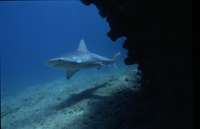 They are back. The guys with the boat, I mean - they are back in the bay. On the boat. With tanks. And - with bait. We meet them as they struggle to keep the box with dead fish and unidentified animals entrails on the bottom. There is three of them, armed with a high tech video camera. They smile, they are nice guys really, we start chatting. I'm dying to remind them that diving is not allowed in the bay but we are guests in this country and it just would not be right for me to remind them their own laws. And on the other hand I am sure tanks could only be of hinderance: these shy sharks avoid shadows, let alone a stream of bubbles! I take my revenge watching their expression when I drop a casual remark: "Female sharks usually don't eat when they are pregnant!" To be honest we are almost grateful that they proved this to us: sharks totally ignored the feast (and divers too). They are back. The guys with the boat, I mean - they are back in the bay. On the boat. With tanks. And - with bait. We meet them as they struggle to keep the box with dead fish and unidentified animals entrails on the bottom. There is three of them, armed with a high tech video camera. They smile, they are nice guys really, we start chatting. I'm dying to remind them that diving is not allowed in the bay but we are guests in this country and it just would not be right for me to remind them their own laws. And on the other hand I am sure tanks could only be of hinderance: these shy sharks avoid shadows, let alone a stream of bubbles! I take my revenge watching their expression when I drop a casual remark: "Female sharks usually don't eat when they are pregnant!" To be honest we are almost grateful that they proved this to us: sharks totally ignored the feast (and divers too).
The "girls" (no male yet in the bay) really had a bad day today, more snorkellers got in the water to (try to) see them.
But there is great news: today I saw a female with a distorted jaw! I played hide and seek for two hours to take a photo of her face; needless to say, she won. Both last year and the year before I photographed a shark with a distorted jaw. But the pics were taken from different angles so we cannot say for sure it is the same animal. See it for yourself:
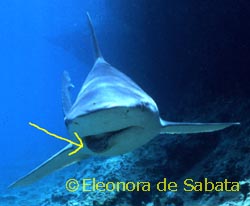 |
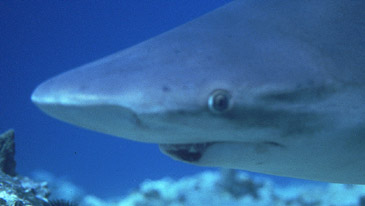 |
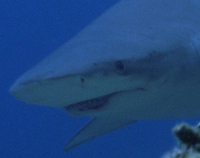 |
| "crooked mouth" 2001 |
"crooked mouth" 2002 |
"crooked mouth" 2003 |
Simona says it would be very strange to have so many deformed sharks. Of the 250+ blue sharks she handled, she has only seen one with a deformed jaw. If only I could take a picture of her... If only she turned out to be the same of last year or the year before (and then both) it would be the definitive proof that these sharks come year after year in the same place. A big IF.
May 19th, monday
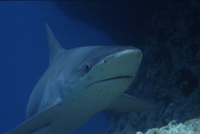 8 cars full of snorkellers arrive at the beach at 8am, just when we are getting in the water. Today is a national holiday, offices are closed and everybody enjoys this spectacular sunshine on the beach. Sharks don't appreciate this flood of people and leave. There is not much we can do today.The two divers we met yesterday came to meet us last night. They are shark-lovers and are afraid that the publicity this place got after the publication of an article in the local diving press last year, will disturb the sharks. They say the Turkish government lifted the ban on scuba-diving in the bay; others say diving is still prohibited. 8 cars full of snorkellers arrive at the beach at 8am, just when we are getting in the water. Today is a national holiday, offices are closed and everybody enjoys this spectacular sunshine on the beach. Sharks don't appreciate this flood of people and leave. There is not much we can do today.The two divers we met yesterday came to meet us last night. They are shark-lovers and are afraid that the publicity this place got after the publication of an article in the local diving press last year, will disturb the sharks. They say the Turkish government lifted the ban on scuba-diving in the bay; others say diving is still prohibited.
2May 20th
Rumors about fishermen catching "our" sharks keep coming from different people, but they all seem to originate from the German photographer who saw fishing boats and spearfishermen in the bay. We are perplexed: we have indeed seen fishing boats laying nets in the bay, but we doubt sharks this big could be caught with nets. And about spearfishing... they could have caught one shark, but the others would have fled at once. Anyway - it is true that there are less sharks than last year. But perhaps it is because of the temperature of the water, which is much higher than last year (23°, says my Apneist computer), so perhaps the season is well advanced and maybe some sharks have already come and gone, including the males which we have not seen yet. Or they are still to come? We'll see.
May 21st - a tropical sea!
 |
| The rabbit fish, an immigrant from the Red Sea, has settled in the bay. |
Looking at the animals that live in this bay it is quite clear that the Med is changing. The second most abundant fish in the bay, after the ubiquitous damselfish (Chromis chromis), is the rabbit fish (Siganus sp.). It is a tropical fish, its ancestors arrived into the Med from the Red Sea through the Suez Canal. They settled in this area of the Med, where the water is warm and predators and competitors scarce. In this bay they "took the place" of "salpe", and you see them grazing sea-weeds on the rocks. But they are not the only "foreigners" in the bay: today we saw a very shy flutefish and a gigantic pesce balestra.
 |
| The parrotfish has always been present in the Mediterranean and is not an immigrant. |
The changing Med is really a fascinating subject. The research team Simona belongs to at Icram runs a program called ALIEN on alien species in the Med. Several fish that swim in this bay may at first glance seem tropical - but barracuda, parrotfish and small pesci balestra which hide in the rocks are endemic of the Mediterranean.
May 22nd, thursday
Pregnant sharks don't eat, a trick devised by Nature to avoid sharks eating their own babies after delivery. Or at least this is what the sacred texts of shark biology say.
Alas, our sharks can't read.
A team of Turkish videographers who have just arrived showed us some very disturbing (to us) footage; our sharks were not only eating, but feasting on a banquet of sardines!! We are speechless. No doubt this is our bay, and these are "our" sharks. But they looked so different! Gone was their cool and relaxed way of swimming - these were fast, nervous sharks, quick and fast and agile, arriving at full speed on the sardines, determined and very precise in homing in on their target. The only consolation is that apparently this documentary was filmed quite late in the season, around mid-june: perhaps the females had already delivered their pups, so maybe that's why they were so hungry! We go to bed a bit depressed.
May 23rd
After twenty years of diving in the bay, the Turkish cameraman has never seen a small shark here. And today it's his turn to be proved wrong! The first shark we see today is a small shark - not much more than a metre long, definitely smaller than all the others. Simona will excuse me when I say it really has a... "puppy face"! She is small and her girth considerable. We will only see her once, but her sight started a flood of thoughts which we will ponder about during the long 7 hours we spend in the water today. We had started thinking that this bay was "just" a mating and not a puppying area; lo and behold, here comes a baby. It is not a newborn but certainly it is not an adult. What is she doing in the bay??
May 24th: sharks don't eat!!
And then again, perhaps sharks do read books! The TV crew started feeding the sharks but not one arrived at the scene. They prepared a feast of sardines and other fish on the bottom, set running videocameras and got out of the water to check on the external monitor what was going on. Which was absolutely nothing. We waited three long hours and not one shark came to feed. What's more, they all totally avoided  the area. In a way we are pleased, this seems to confirm that pregrnant sharks do not feed (well, at least today they didn't). But then another question arises: we have non-pregnant ladies in the bay. Why don't they eat? the area. In a way we are pleased, this seems to confirm that pregrnant sharks do not feed (well, at least today they didn't). But then another question arises: we have non-pregnant ladies in the bay. Why don't they eat?
Raymond, a good friend and a passionate supporter of our research, has joined us. He is intrigued by the amount of (as yet) unanswered questions that buzz in our heads!
May 25th: where do sharks go, after they leave this bay?
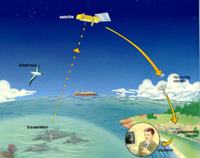 |
| Satellite tags record the position of the animal for many months. After the time is up, the tag detaches automatically, floats to the surface and then transmits the data by email via satellite. |
Our shark ladies do not fail us today - still they did not eat. The funny thing is that the feast and cameras divide the bay in two and sharks are therefore concentrated in the areas before and after them. While Simona and I can watch groups of up to 7 sharks at the same time, the TV crew sees no sharks at all.
It is the last day of our work here. We will leave tomorow, and in a few weeks' time sharks will leave too. Where will they go? Sandbars are migratory sharks - in America one was reported to have swam for 3700 km! There is only one way to find out where these Mediterranean sharks go: mark them with satellite tags. Raymond offers to help - to us this is a dream come true.
Our days in the bay are up. Like in a (b-) movie Crooked Mouth, the shark I have been photo-hunting all these days, bids us farewell. And she even let me video her, although not from the right angle to tell if it's really the one we saw last year, and the year before. So long, Crooked Mouth!
Simona's thoughts
Alas we had to leave. But we have recorded a wealth of very important data which we will have to study in the following months.
The first thing that comes to mind is that we have seen only females - males therefore travel elsewhere. But where? And when do they come back? These are still open questions. Meeting the TV crew was important, because (hopefully) they will keep us informed of when sharks are in the bay. They also promised to show us the tapes they filmed last year - we will try to identify those sharks and see if there is anyone we classified this year. My task now is to work on this and last year's tapes to see if we can ID the sharks from the scars and marks. I will also analize the profiles of every fin we have images of - I will get some reference measurement, just like other researchers do with dolphins and whales so we can identify the animals from fin profiles too. It will be a time-consuming job but I will have to do it quickly as we plan to present this work at this years' EEA meeting, which will take place in San Marino at the end of September. You are all invited!
May 31st: IT'S THEM!!!
At last we have the proof: sharks do come back to the bay year after year! We have started working on the slides we took last week. It's a long and time-consuming job, for we have to catalogue them, adding the notes we took while in the water. We then have to recognize the individuals based from the scratches and marks they have, compare them with the sharks we already ID from video while we were in Turkey. It's a kind of immense solitary game with cards - hundreds and hundreds of slides to re-arrange to pair sharks. A long task which is far from completed but we already produced results: at least three animals we photographed in 2003 were here last year!
|
|
|
|